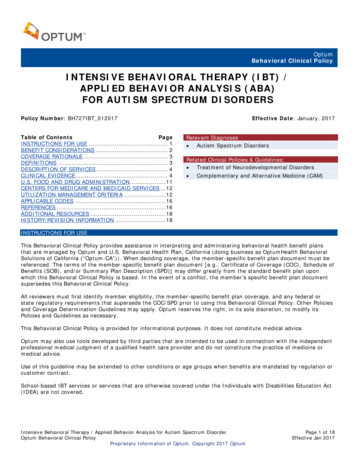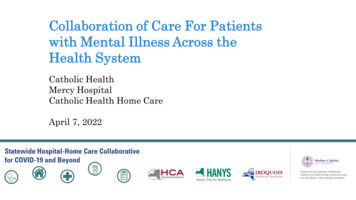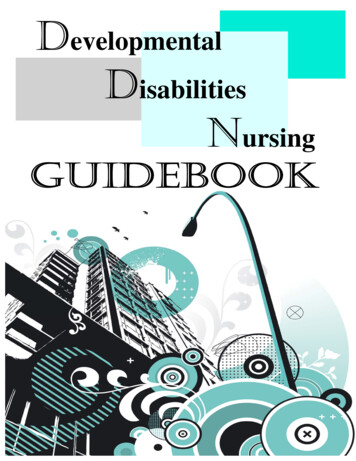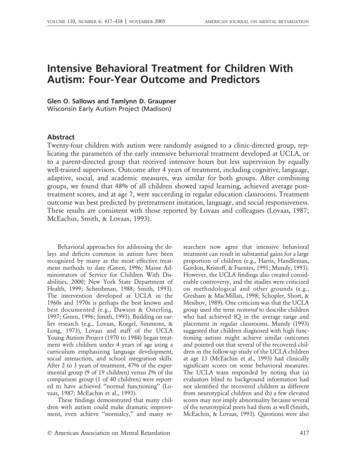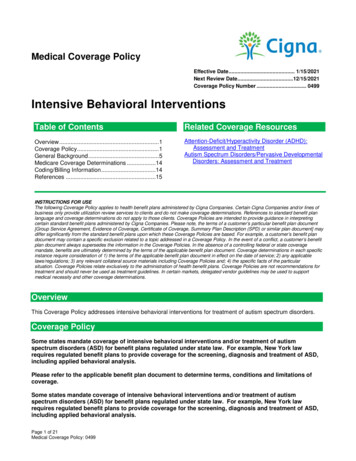
Transcription
Early Intensive Developmentaland Behavioral InterventionA Summary of the Literature Concerning Access to and Use of TherapyAuthor: Emma ConnellA P R I L2 0 2 0
Demographic disparities in diagnosis and careFor interventions to be most effective, children with autism spectrum disorder (ASD)should be identified and served early and intensely. This involves early identification ofwarning signs, prompt diagnosis of ASD, and a smooth transition into receiving servicesand therapy, to be complemented by special education services through schools (St. Amant,Schrager, Pena-Ricardo, Williams, and Vanderbilt, 2018). However, not all children havethe same access to these critical features of early and intensive care. The literature discussesthe ways in which some children receive a diagnosis and treatment later and less intensivelythan their peers.The Minnesota Department of Human Services contracted with Wilder Research to conductresearch and evaluation related to their Early Intensive Developmental and BehavioralIntervention (EIDBI) benefit for the treatment of people under 21 years old with autismspectrum disorder (ASD). This literature review is intended to inform DHS and other EIDBIstakeholders of identified barriers to receiving intensive interventions for autism. We haveproduced other reports and presented findings about the children who are receiving theEIDBI benefit and the impact of the services they are receiving as part of the ongoingEIDBI evaluation.Differences in identification and diagnosis of autismOverall, the United States has improved over time in diagnosing children with autism atan earlier age. This earlier identification and diagnosis of autism allows interventions tobe utilized at a critical stage of development and for a longer length of time. Children withautism in the United States have not benefited from this improvement equally, however(Fountain, King, and Bearman, 2011). Disparities exist for children of color, children offamilies with fewer financial means, and children who are less connected or have worseaccess to healthcare systems, in particular. Parental awareness and perception of signs ofautism can also play a role in when children are formally diagnosed with autism.Race, ethnicity, home language, and cultureA strong evidence base shows disparities in the age at which white children and black,indigenous, and children of color (BIPOC) are diagnosed with autism spectrum disorder(Daniels and Mandell, 2014; Fountain et al., 2011; St. Amant et al., 2018). There are a varietyof hypotheses as to why this difference exists, all of which are related to social and culturalfactors; there is no evidence suggesting that autism prevalence varies by race (Burkett,Morris, Manning-Courtney, Anthony, and Shambley-Ebron, 2015). A systematic review ofstudies found that the majority of the literature highlights significant differences in age atEIDBI Literature Review1 Wilder Research, April 2020
diagnosis between white children and children of color, and one study found that AfricanAmerican children specifically are diagnosed later than their peers of other races (Danielsand Mandell, 2014). African American children have been found to be misdiagnosed, andAfrican American children with less severe symptoms are more likely to be undiagnosedthan their white peers (Burkett et al., 2015). Research has identified Indigenous and Hispanicchildren to be the least likely to be identified as having ASD, with at some points in timehalf as many diagnoses as white children (Travers, Tincani, and Krezmien, 2011).There are a variety of reasons why children of color are not being identified and diagnosed asquickly as white children, and why parents and caregivers of children of color might delaydiagnosis. Implicit bias among educators, healthcare providers, and others who play a role inidentifying signs and symptoms of autism is clear; African American children with autismare 5.1 times more likely to be misdiagnosed as having an adjustment disorder, and are2.4 times more likely to be misdiagnosed as having a conduct disorder (Burkett et al., 2015).Expectations of what appropriate and typical behavior are vary by cultural background ofboth children and those observing them. Parents of different backgrounds have beenfound to notice different potential signs of autism; parents in India noticed difficultywith socialization as a first “red flag,” whereas parents in the United States noticeddevelopmental delays and regression in speech first (Mandell, Ittenbach, Levy, and PintoMartin, 2007). Different expectations of how and to what extent children socialize makean impact on what seems indicative of autism or another underlying condition to parentsand others working with children.Even when parents do identify warning signs that their child might be on the autismspectrum, they may hesitate to have their child formally diagnosed or receive treatment.Longstanding inequities in healthcare treatment for African Americans in the United Stateshave created a sense of distrust in the healthcare system among many African Americanfamilies (Burkett et al., 2015). A qualitative study of African American families who have achild with autism found that parents often believe that the best way to protect their children isto keep them from the stigma of an autism diagnosis altogether or to delay the process ofreceiving a medical diagnosis in order to avoid unpleasant experiences with doctors andother healthcare providers.Language also plays a significant role in the age at which children with autism are diagnosed.Studies have found that parents’ primary language played a more substantial role in the age atwhich their child was diagnosed with autism than ethnicity did (St. Amant et al., 2018).Singh and Bunyak (2019) conducted a systematic analysis of qualitative studies examiningdisparities in autism diagnosis and treatment and found that language barriers were aconsistent problem across every aspect of getting an autism spectrum disorder diagnosis,including scheduling meetings and coordinating transportation to doctors’ appointments.EIDBI Literature Review2 Wilder Research, April 2020
This fits with other research that shows that children with immigrant mothers have laterdiagnoses than their peers (Fountain et al., 2011).The most recent available data for Minnesota shows that one in 44 children have beenidentified to have autism spectrum disorder (MN-ADDM, 2020). Prevalence is similar fornon-Hispanic white children and non-Hispanic, non-Somali black children (1 in 41 and1 in 40, respectively). Prevalence of identified autism is lower in non-Hispanic, non-HmongAsian or Pacific Islander children, Hispanic children, and Hmong children (1 in 60, 1 in 57,and 1 in 62 respectively). Prevalence of identified autism is higher in Somali children(1 in 34). Small sample sizes restrict the ability of the Minnesota Autism DevelopmentalDisabilities Monitoring network (ADDM) to draw firm conclusions about differences inprevalence of identified autism for the Somali, Hmong, and Indigenous communities inMinnesota, though. Those interested in autism prevalence among different races andethnicities in Minnesota should continue to monitor results from ADDM as experts learnmore over time.Socioeconomic statusChildren of higher socioeconomic status and with more highly educated parents arediagnosed with autism earlier than their peers (Fountain et al., 2011). Research has foundthat socioeconomic status is a stronger predictor of the child’s age at diagnosis than eventhe severity of their symptoms. Similar to overall trends in diagnosis, though, this wealthgap for the age of diagnosis has been shrinking over time. For those born in the early 1990s,wealthy children were diagnosed 16 months earlier than children from low socioeconomicstatus families; for children born in 2000, this shrank to a gap of six months between lowsocioeconomic status and wealthy children.The wealth of a child’s family appears to be more important than the wealth of theircommunity. There are mixed findings on the importance of living in communities withhigher median property values, lower rates of poverty, and other markers of communitywealth on when a child is diagnosed with autism (Daniels and Mandell, 2014).GeographyA 2014 systematic review found mixed results around how access to nearby medicalfacilities can play a role in age of autism diagnosis, but there is some evidence to showthat that children living in rural or otherwise non-metropolitan areas receive later diagnoses(Daniels and Mandell, 2014). Additionally, areas with more neurologists and psychiatrists, aswell as areas close to a medical school, have earlier autism diagnoses (Daniels and Mandell,2014). Future studies should examine the differences these areas have in overall diagnosisand misdiagnosis rates.EIDBI Literature Review3 Wilder Research, April 2020
Elder, Brasher, and Alexander (2016) specifically examined barriers to early interventionfor those living in rural areas. In this study, individuals working in the field and parentsof children with autism discussed the general dearth of services and providers available tothem in rural areas and the time and cost associated with driving to a more urban area toaccess services. This lack of services and providers can lead rural parents to use unprovenor alternative treatments (such as the use of gluten-free and casein-free diets, vitaminsupplements, or forced eye contact) with their children (Elder et al., 2016).Existing connections to the medical communityChildren who are consistently seeing a primary care doctor are more likely to receive anearlier diagnosis of autism; children who switched pediatricians in their first five yearsof life had later diagnoses than their peers (Daniels and Mandell, 2014). Additionally,children who were referred to specialty services and early intervention were diagnosedearlier than children who did not receive such a referral, and those who were referredfrom early intervention services (as opposed to receiving referrals from doctors’ offices,parents, or schools) were diagnosed at an earlier age.Simply seeing more doctors does not always result in earlier diagnosis, however. Somestudies have found that seeing a greater number of physicians or other healthcareprofessionals is associated with a later age at diagnosis (Daniels and Mandell, 2014). Itcould be that seeing a higher number of healthcare professionals indicates that providersare hesitant to diagnose the child with autism or otherwise unsure of how to help parentsidentify the right course of action.Parental awareness and concernParents are often the first to notice and follow up on their child’s signs and symptoms ofautism. Different levels of awareness and understanding of the signs of autism play a rolein when parents bring these concerns to healthcare providers and push for their providerto make a diagnosis.Firstborn children are diagnosed later than their peers. Some researchers have hypothesizedthat new parents are less aware of developmental milestones and when they should occur,so are less likely to identify “red flags” (Fountain et al., 2011).Parental approaches to behavioral difficulties also make a difference in when childrenare diagnosed with autism. Parents who attribute behavioral difficulties to personalitycharacteristics (like being difficult or being spoiled) have children who are diagnosedwith autism later than parents who view behavioral issues as issues with social skillsdevelopment (Daniels and Mandell, 2014).EIDBI Literature Review4 Wilder Research, April 2020
Parents of children with autism often have other concerns about their children that competefor their attention; the majority of children with autism have at least one co-occurringcondition (70%), and 4 in 10 have two or more co-occurring conditions, including bothphysical health issues like gastrointestinal problems and mental health issues like anxietyand depression (Fuld, 2018). Parents who were concerned about other medical issues hadchildren who received later diagnoses than their peers (Daniels and Mandell, 2014).Researchers hypothesize that these other medical concerns “mask” the signs of autismand divert attention away from these potential autism symptoms.Even once parents have noticed a potential sign of autism in their child, they might hesitate tobring their concerns up with their child’s healthcare provider. At other times, parents whobring up concerns might have them dismissed by a provider. Parents might delay discussingpotential signs of autism with their child’s healthcare provider if they distrust healthcaresystems, are discouraged by family and friends, or are told to “wait and see.” In other cases,parents might be concerned about stigma being attached to their child or family after adiagnosis, or simply not be aware of the potential benefits of speaking with a providerand getting a diagnosis is (Korbin, Celeste, Dimitropoulos, Hill, and Kampman, 2019).Even once a parent discusses their concerns with a healthcare provider, children are notalways moved along a pathway of receiving a diagnosis and accessing care. Providers whoare less aware of the signs and symptoms of autism or of what services are available forchildren and families often employ a “wait and see” approach or otherwise downplay anddisregard potential signs of autism (Elder et al., 2016).GenderThere are large differences in identified autism prevalence between boys and girls; boysare four times more likely to be identified as having autism than girls (Maenner et al, 2019).The literature predominately points to potential genetic and biological reasons why boysmore frequently have autism than girls, as autism is a biological condition; however, theway in which autism displays itself is deeply social and cultural (Kreiser and White, 2014).Girls receive more coaching and pressure about how to behave socially than do boys;behavior changes because of this ongoing pressure might mask otherwise identifiablesigns of autism in girls.An emerging evidence base suggests that girls in the United States may be under-identifiedas having autism. This literature documents that girls have delayed diagnosis compared totheir male peers and that girls might have to display more severe symptoms to be diagnosedwith autism (Beeger, Mandell, Wijnker-Holmes, Venderbosch, Rem, Stekelenburg, andKoot, 2013; Frazier, Georgiades, Bishop, and Hardan, 2014; Kreiser and White, 2014).The vast majority of studies concerning autism and how it manifests itself use entirely orpredominately male subjects. Because of that, the ways in which autism may look different inEIDBI Literature Review5 Wilder Research, April 2020
girls and women is largely unexplored, and there could be many more girls and women withautism than the data currently reflect (Kreiser and White, 2014).Differences in access to and utilization of careSimilar to diagnosis and identification, disparities exist in the extent to which childrenare accessing interventions to address their autism spectrum disorder. Underutilizationis pervasive; studies have found that 9 in 10 children with ASD are not fully utilizingbehavioral health services (Nguyen et al., 2016).Race, ethnicity, and cultureRace, ethnicity, and culture play a role in how parents and caregivers perceive signsof autism in their children and how they act on concerns they have about their child’sdevelopment. These factors can also impact how medical, educational, and otherprofessionals respond to signs of autism in children and to questions and concerns fromparents and caregivers, and also the way in which professionals diagnose and providecare for autism.Singh and Bunyak (2019) conducted a meta-analysis of qualitative studies to betterunderstand the ways in which culture affects how families respond to signs of autism intheir children. In their report, they note that some cultures have a strong “wait and see”attitude, in which parents and caregivers will monitor their child over a longer period oftime than parents and caregivers of other cultures before seeking professional care; theynoted that this has been identified in Latinx culture, for one. Attitudes about faith can alsoimpact whether or not a family seeks care for their child. Some parents who are firstgeneration immigrants to the United States said that they believed autism was a temporarycondition which could be cured by faith (Singh and Bunyak, 2019).Willingness to visit a healthcare professional is largely influenced by how one’s culturalcommunity has been historically and is currently treated by the medical community(Singh and Bunyak, 2019). African American communities, for example, have respondedto pervasive disparities in quality of healthcare with distrust in the system. This canexacerbate the problem of disparities (delays in seeking care can worsen health outcomes,which furthers distrust in the system). A lack of cultural competence and the existence ofbias in doctors and other healthcare providers can also contribute to distrust in the medicalsystem among various cultural communities. Latinx and African American families ofchildren with autism may be more likely to feel that their concerns have been dismissedby medical professionals and that medical professionals will assume their families havelittle education or a limited understanding of autism and other related conditions (Singhand Bunyak, 2019).EIDBI Literature Review6 Wilder Research, April 2020
Additionally, different cultural groups perceive autism differently. Stigma associated with thediagnosis varies across different cultural and ethnic groups (Singh and Bunyak, 2019). Latinxparents have reported a need to “cover it up” when speaking about their child’s ASDdiagnosis within their communities, and members of the African American communityhave reported that stigma around all kinds of disability is high in their community. Similarfindings have come from studies with Korean and South Asian Indian communities, inwhich parents and caregivers feel stigmatized and shamed for their child’s autism diagnosis.In addition to these barriers, new American families often face logistical barriers that preventthem from accessing the care their child needs. Families with undocumented status maybe scared to go to a healthcare professional for fear of deportation (Singh and Bunyak, 2019).Language barriers are difficult to overcome at all steps of the process, from scheduling anappointment and discussing concerns with a doctor to filling out paperwork to access servicesfor a child.Studies in the U.S. have found that children of parents who primarily speak English havebetter outcomes than their peers. These children are more likely to access more hours ofservices through state-based services than children whose parents primarily speak a languageother than English (St. Amant et al., 2018). Additionally, parents’ primary language beingEnglish was associated with a higher likelihood that their child’s IEP contained socialskill goals and communication skill goals (St. Amant et al., 2018).Indigenous families who live on reservation face additional barriers to accessing services.Provider shortages particularly affect rural communities, within which most reservationsreside (Harley, 2018). Coupled with provider shortages are transportation issues; rural tribesare often far from providers and transportation options to get to those providers are limited,particularly for those with disabilities. General barriers for Indigenous communities living onreservations to access services include poor coordination among agencies, limited knowledgeor understanding of tribal communities among providers, and financial barriers to care amongindividuals. Research also highlights limited enforcement of laws intended to protectindividuals with disabilities and limited tribal planning to protect and support people withdisabilities as barriers to service access (Harley, 2018).Socioeconomic statusLimited access to resources for families with low socioeconomic status serves as a barrierto using services. Therapy options are often cost prohibitive unless families have accessto high-quality health insurance (Singh and Bunyak, 2019). Accessing health insuranceoptions that are available to families of children with ASD can be difficult. The process isoften convoluted, which takes time and energy to understand. Parents struggling to makeends meet, especially those with a child on the autism spectrum, have little extra time andEIDBI Literature Review7 Wilder Research, April 2020
energy to dedicate to navigating systems. Lower socioeconomic status families are morelikely report that they do not have enough information about resources available to them(Singh and Bunyak, 2019). Financial barriers go beyond the cost of the therapy and careitself; for example, families without access to a car and with limited public transit optionsface difficulties in getting to appointments for their child’s autism (Elder et al., 2016).Geography also plays a role in the difficulty that low-income families face. Rural familieshave discussed financial burdens as a major barrier to accessing appropriate services fortheir children with ASD (Singh and Bunyak, 2019). In rural communities, therapy andhealthcare providers are few and far between. The lack of resources and avenues to accessevidence-based therapy is significantly associated with the use of alternative therapies andfalse “treatments” for autism that have no empirical evidence to support their effectiveness(Elder et al., 2016). Children of low-income, rural families are at a greater risk of not beingable to benefit from therapy at the age that it matters most, and are also at risk of being putthrough therapeutic approaches that are at best unhelpful and can even be harmful (Elderet al., 2016; U.S. Food and Drug Administration, 2019).Families with low socioeconomic status face particular challenges in balancing workschedules with caregiving responsibilities. This can be particularly difficult for parentsof children with autism who would benefit from time-intensive therapies, such as ABA(Singh and Bunyak, 2019). Individuals on the lower end of the socioeconomic spectrumare more likely to do shift work, in which workers’ hours vary widely from week to week.This makes scheduling and managing calendars difficult, especially when navigating differentsystems to access the range of care needed to best serve a child with autism. This challengeis particularly salient for people of color. Studies show that workers of color are significantlymore likely to work on call and to have trouble getting time off (Storer, Schneider, andHarknett, 2019). The challenge of navigating childcare responsibilities and work obligationsis sometimes insurmountable. Some parents will shift to working part-time or leaveemployment altogether because of childcare obligations (Singh and Bunyak, 2019). Thisdisproportionately affects mothers and other female caregivers, who are expected to carrythe logistical, mental, and professional burdens of caregiving to a much greater extent thantheir male counterparts.GeographyAs mentioned above, families living in rural areas face a unique set of challenges inaccessing services. Transportation to therapy and other care can be challenging if providersare distant from the family’s home. Scheduling challenges and caregiving responsibilitiesfor other children are compounded when substantial travel to and from appointments isnecessary (Elder et al., 2016). The lack of available providers within a reasonable distancecan also be frustrating and demoralizing for patients. As noted above, a sense of helplessnessEIDBI Literature Review8 Wilder Research, April 2020
and insufficient access to care can lead families to turn to alternative therapies and methodsof care that are ineffective and potentially harmful for children with ASD (Elder et al., 2016).Other barriers to accessing careThere are numerous other barriers to accessing care related to family demographics, withvarying amounts of literature examining these issues. Other groups that are mentioned in theliterature as experiencing barriers are foster care youth, who frequently move and generallyface instability in their home life, and transition-age youth, who are adjusted into adultservices and systems that are difficult to navigate and understand (Singh et al., 2019).This is not an exhaustive list of the barriers to diagnosis and care that are related to a family’sdemographics. Those working in the field of autism and autism services should continuallythink about the various hurdles different families face and work to ease burdens to accessnecessary care.Approaches used to improve access to careWhile it is discouraging that there are disparities in early diagnosis and access to care forchildren on the autism spectrum, there are concrete things that providers and others cando to help. Below are some examples from the literature about ways in which state agenciesand providers can work to help children with autism from all backgrounds get their diagnosisearlier and access the services they need as soon as possible.Policy changesThe Centers for Disease Control and Prevention (CDC) launched an effort in 2007 topromote Learn the Signs, Act Early state teams. These multidisciplinary teams aim toimprove early identification and effective intervention for young children who exhibitsigns of autism (Rotholz, Kinsman, Lacy, and Charles, 2019). The South Carolina ActEarly Team (SCAET) was established in 2009, and its work around “presumptiveeligibility” provides a promising example of ways in which states can improve earlydiagnosis and treatment.The SCAET included members with decision-making authority from state agencies,advocacy organizations and foundations, universities, and health care systems, as well asfamilies affected by autism (Rotholz et al., 2019). The action team adopted “presumptiveeligibility” and developed a process by which very young children could start accessingservices once they are determined to be at risk of autism, rather than waiting until theyhave received a formal diagnosis. This strategy has appeared to work well; after theadoption of this approach, there was a large increase in the number of children from 18 toEIDBI Literature Review9 Wilder Research, April 2020
36 months old – the most critical time to begin services – who were eligible for andreceiving Early Intensive Behavioral Interventions (EIBI). In 2010, 53 children in thisage range were eligible for services, which increased to 265 children in 2015. Authorsnote that presumptive eligibility did not appear to provide services to children whoultimately will be determined to not have autism: only 2.5% of children who receivedearly EIBI services through presumptive eligibility were later found to not have autismfrom a comprehensive evaluation.This is one example of how policy changes can make an impact on service acquisitionfor children with autism. States should share their approaches, what they have learned,and measurable outcomes with one another to inform constructive and evidence-basedpolicy change.State agency and provider-level strategiesThe literature identifies a variety of ways that state agencies and providers can work togetherto decrease disparities in diagnosis of and services for children who have autism.To address disparities in diagnosis, some suggest that state agencies and providers worktogether to develop training materials for primary care doctors to better address parentalconcerns of potential signs of autism (Daniels and Mandell, 2014). Many primary caredoctors will suggest a “wait and see” approach to parents, suggesting that the child willgrow out of their symptoms and atypical behaviors and catch up to where they should be,developmentally. This “wait and see” approach delays diagnosis, which also delays access tosupport services and therapeutic interventions at the time it is most effective.Relevant state agencies have a variety of tools they could utilize to help families incommunities that have identified disparities in diagnosis age and therapy access. Theseinclude increasing case management services and conducting culturally sensitive andspecific outreach to families of different races and ethnicities (Nguyen et al., 2016). Theliterature suggests that state agencies can work to increase overall capacity in the field byfunding more treatment programs and increasing the total workforce (Elder et al., 2016).Public awareness strategiesAt a fundamental level, many people in the general public do not have an understandingof the warning signs of autism and the importance of following up on those symptoms toget a diagnosis. Many parents are scared to question their child’s development and receive adiagnosis of autism or another condition, leading them to put off raising concerns. Thiscan be reinforced by “wait and see” instructions from pediatricians and primary care doctorswhen families do raise questions about signs of autism in their children.EIDBI Literature Review10 Wilder Research, April 2020
Better information about what to look for and what to do when family members havequestions or concerns about whether or not their child has autism is critical. Nguyen et al.(2016) suggests broad public education and awareness campaigns, with a specific focuson lower income households and households that are on public insurance, as they are oftendiagnosed later and receive fewer services for their child.Outreach and education activities should be conducted in places where families, especiallythose with young children, regularly gather. These include places like cultural centers,churches, daycares, and public assistance agencies (Nguyen et al. 2016).Wilder Research and the Minnesota Department of Human Services worked together to createthe following resources, w
research and evaluation related to their Early Intensive Developmental and Behavioral Intervention (EIDBI) benefit for the treatment of people under 21 years old with autism spectrum disorder (ASD). This literature review is intended to inform DHS and other EIDBI stakeholders of identified barriers to receiving intensive interventions for autism.
